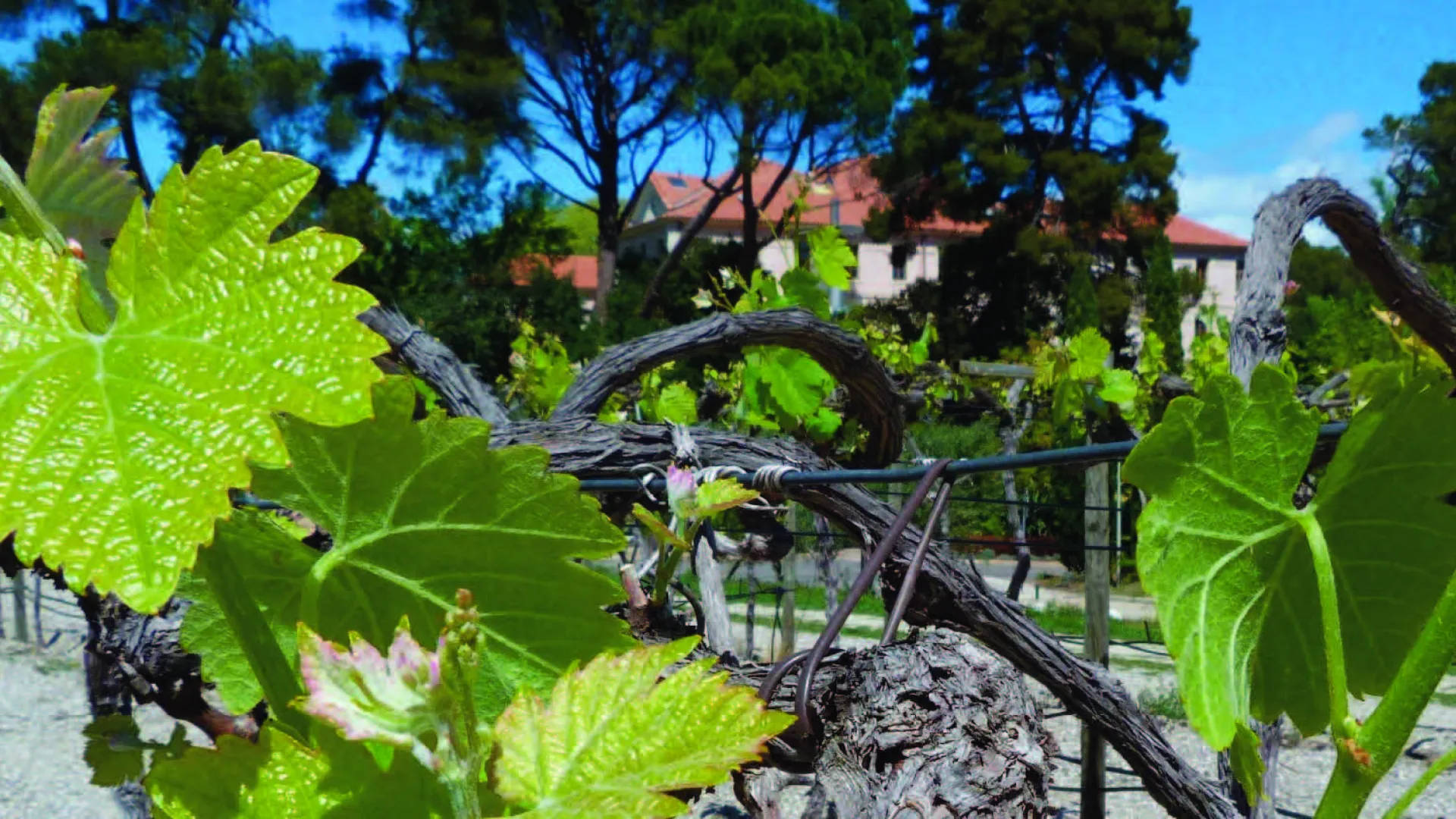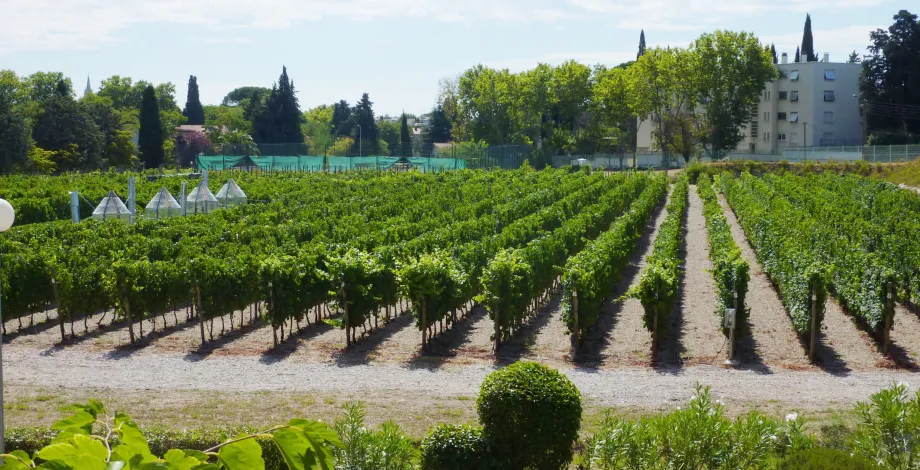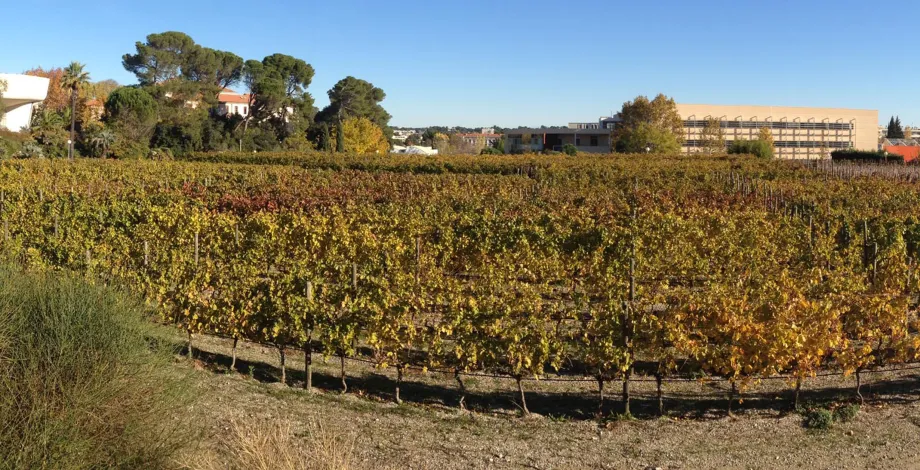Covering 1 hectare in the heart of the Montpellier SupAgro - INRAE La Gaillarde campus, it is the world's first artificial vineyard, cultivated on inert substrate using fertirrigation techniques.
The Pierre Galet experimental vineyard is divided into 3 areas:
- An ampelographic collection consisting of 275 grapevine varieties, hybrids, rootstocks and Vitaceous species
- A set of viticulture managment systems for syrah grapes representative of the diversity present in vineyards around the world
- A 1000 m² area able to accommodate diverse soil-less experimental devices adapted more particularly for work on the scale of the entire plant.
The Institute for Higher Education in Vine and Wine at Montpellier SupAgro coordinates the management of the vineyard in collaboration with the joint research and experimental units of INRAE Occitanie-Montpellier centre.
Several functions on the campus:
- Pedagogic: viticulture training programs, particularly those involving subjects such as ampelography and ecophysiology of vines, use the vineyard in coursework.
- Research: joint research teams based on campus working specifically on the subject of grape vines use the vineyard for observation, sampling and experiments.
- Federation bringing together campus staff and students. Anyone interested is welcome to help with the grape harvest, allowing staff from different backgrounds to meet in a moment of conviviality and solidarity. Teaching teams also are offered opportunities to organize one-day integration sessions with in-coming classes and to involve foreign students enrolled in summer courses. This unifying event, a form of team building, reinforces a feeling of collective belonging and enables the discovery of the experimental vineyard and all of its related activities. Unique in the world, in the heart of the campus and on the doorstep of the city!
Some history: the need for the first artificial vineyard in the world
In 1998, Montpellier SupAgro envisaged the creation of a "vineyard of the future" on the Montpellier campus as the vineyards on the La Gaillarde site were becoming old. It was essential to maintain a collection of vines on site, both for the needs of the viticulture training programs and the traditional image of the school. Alain Carbonneau, Professor of Viticulture at Montpellier SupAgro since 1993, described the problem to the Director of the School, Mr. Paul Raynaud, as follows: "If we do not completely renovate the old collection, including the soil, we will have no plot on which a new collection of vines could be planted under correct conditions". Paul Raynaud embraced the project and, with the support of the services of the Conseil Général de l'Hérault, commissioned a total renewal between 1999 and 2000.
Soil quality and objectives: avoiding the development of nematode virus vectors
In less than one month, the following was achieved over 1 hectare: excavation of old soil to a depth of 2 m, evacuation of marl earth to be used for the "La Lyre" roundabout, installation of an insulating tarpaulin on the bottom held by a bed of pebbles with a geotextile film above to hinder rooting, filling to an average height of 1.5 m with the new substrate made up of alternating layers of coarse river sand and small crushed quarry stones, chosen to deter the development of Xiphinema index nematodes, vectors of the degenerative grapevine fanleaf virus. The first artificial vineyard of the world, one renewable on the spot, was thus established! All of these operations and the general plan of the vineyard were carried out under the supervision of Alain Carbonneau with daily technical assistance from Gérard Bruno (INRA).
Plant material, management and integrated protection
The plant material in the collection was chosen by Jean-Michel Boursiquot, Ampelography Professor at Montpellier SupAgro, and produced by ENTAV. The plants were grafted onto Selection Oppenheim No. 4 (SO4) to homogenize their development and ensure tolerance of other soil pests. The planting took place in February 2000. Trelisses were set up a few months later; for most of the grape varieties, trellis vine training and Cordon de Royat pruning techniques were used. Due to the nature of the substrate, a regular supply of water and mineral elements is required: an automated system of fertilizing irrigation was set up and is regularly improved. Integrated protection requires regular and meticulous monitoring of pest and parasite risks, with the dual objectives of improving efficiency over several hundred varieties and respecting the environment.
Diversity of plant material
The plot includes a collection of about 180 cultivated varieties (large sample of wine and table grapes), main rootstocks and Vitaceous species, 12 vine training or management systems for Syrah (Gobelet, 3 different Trellis, Free cordon, Vertical cordon, Lys, Minimal pruning, Single curtain, Double curtain, Tendone, Lyre), and a soil-less research area, in the centre.
Vineyard management
New vineyard management techniques are implemented to respect the environment with the practice of mechanical weeding, the balanced management of inputs (water, N) and the absence (or very limited use) of pesticides. Substantial work has been carried out on the traceability of crop practices, in particular with regard to phyto-sanitary treatments.
Place
L'Institut Agro Montpellier
Campus de La Gaillarde
2 place Pierre Viala
34060 Montpellier - France
L'Institut Agro Montpellier
2 place Pierre Viala
34060 Montpellier - France
Tél. : +33 (0)4 99 61 22 00 Tél. : +33 (0)4 99 61 22 00
Fax : +33 (0)4 99 61 29 00
contact@supagro.fr




















